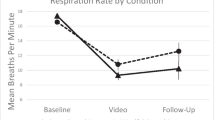Abstract
Psychophysiological observations, especially PETCO2 and EEG, during relaxation training with deep-diaphragmatic breathing and mental imagery, suggest that the addition of certain types of music “deepens” breathing and quickens relaxation: PETCO2 “normalizes” with decreased respiration rate, and EEG shows decreased average theta and increased alpha. The combined psychophysiological indices suggest that music potentiates the hypometabolic counterarousal state. And clients unanimously report that they enjoy it.
Similar content being viewed by others
References
Badawi, K., Wallace, R. K., Orme-Johnson, D., & Rousere, A. M. (1984). Electrophysiologic characteristics of respiratory suspension periods occurring during transcendental meditation.Psychosomatic Medicine, 46 267–276.
Banquet, J. P. (1972). EEG and meditation.EEG and Clinical Neurophysiology, 33 454.
Beary, J. F., Benson, H., & Klemchuck, H. P. (1974). A simple psychophysiologic technique which elicits the hypometabolic changes of the relaxation response.Psychosomatic Medicine, 36 115–120.
Comroe, J. H. (1974).Physiology of respiration (2nd ed.). Chicago: Yearbook Medical Publishers.
Farrow, J. T., & Hebert, J. R. (1982). Breath suspension during transcendental meditation.Psychosomatic Medicine, 44 133–135.
Fried (1987a)
Fried, R. (1987b). Relaxation with biofeedback-assisted guided imagery: The importance of breathing rate as an index of hypoarousal.Biofeedback and Self-Regulation, 12 273–279.
Fried, R. (1990a). Integrating music in breathing and relaxation: I. Background, rationale, and relevant elements.Biofeedback and Self-Regulation, 15 161–169.
Fried, R. (1990b).The breath connection New York: Plenum.
Kasamatsu, A., & Hirai, T. (1969). An electroencephalographic study of Zen meditation (Zazen).Psychologia, 12 205–225.
Kesterson, J., & Clinch, N. (1985). Peripheral and central control mechanisms during respiratory suspension in transcendental meditation as evidenced by latency, hypoxia, and RQ changes.Society for Neurosciences, Abstract, 11 1144.
The Hyperventilation Syndrome, Research and Clinical Treatment. Baltimore: Johns Hopkins University Press.
Author information
Authors and Affiliations
Rights and permissions
About this article
Cite this article
Fried, R. Integrating music in breathing training and relaxation: II. Applications. Biofeedback and Self-Regulation 15, 171–177 (1990). https://doi.org/10.1007/BF00999147
Issue Date:
DOI: https://doi.org/10.1007/BF00999147




